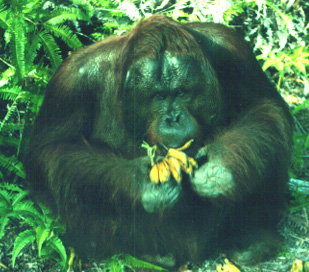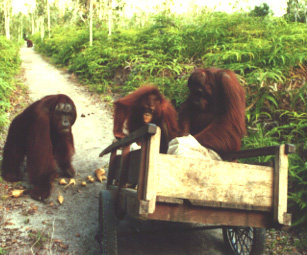
Tanjung Puting National Park, Kalimantan, Indonesia ©1997, photos and story by Dory Lynch "Staring into the eyes of an orangutan," Dr. Birute Galdikas remarked, "is like seeing into the eyes of God." Galdikas should know. She's spent the last twenty-five years studying orangutans, now an endangered species which number only about 10,000 individuals worldwide. Formerly they inhabited most of Asia; but now due to habitat destruction, they can only be found in the wild on two Indonesian Islands: Kalimantan and Sumatra. To visit these primates in their natural habitat, consider a trip to the reserve at Tanjung Puting National Park in Central Kalimantan Province (a short hour flight from Jakarta, Indonesia) on the island of Borneo. Not only can you see orangutans there, but also grey gibbons, Malayan sun bears, maroon leaf monkeys, and proboscis monkeys (the latter give a fine show as they sail through the air, jumping from tree to tree.) But it's the orangutans which draw visitors to the park--over a hundred of them there--some being rehabilitated into the wild after being discarded as exotic pets. When we visited the park several years ago, we took a plane from Semarang to Pangkalan Bun, and a bemo to the town of Kumai where we secured an entry permit at the park office. Because Tanjung Puting National Park is a wildlife preserve, the number of visitors is limited. We hired a speedboat for the forty-five minute trip up river to the village of Tanjung Harapan which serves as the entrance to the park. As daylight faded, the lights of the Rimba Hotel came into view and something clattered against the engine. We'd just driven over a huge log. The engine sputtered to a stop, and our driver paddled the small boat to the dock. The Rimba Hotel is the only lodging in the park. It's a lovely hotel with gracious employees, and a peaceful setting on the banks of the Sekunir River. Next to the dock, the staff have constructed a wooden cage in the river for swimming. After some hesitation we swam there, in the cool chocolate-colored waters, although each time we brushed a palm frond, we nearly leaped out of the water, fearing we'd touched the buaya or crocodile which also lives there. The next day, we paddled down to the village of Tanjung Harapan, one of three research sites in the park. Here four orangutans lived: one large male, a pregnant female named Melli, and two younger orangutans: a five year old named Herbie and a three year old called Stan. In two days we managed to see all but the elusive large male who spent most of his time in the forest. The next day we boarded a klotok for Camp Leakey. In the 1970's Galdikas set up this camp as a research area and rehabilitation center for captive orangutans. Now it provides a much needed, protected habitat for the endangered wild orangutan, and for many other rain forest animals also. The slow moving klotok provided a perfect viewing place for wild animals. We saw many varieties of birds, one crocodile, and tens of proboscis monkeys feeding high in the trees. Along the banks of the river are tropical rain forests, freshwater swamps, and mangrove trees. The only signs of humans were a few widely-spaced cabins at the edge of the forest, and the occasional family fishing or taking naps in sampans on the river. We lay on the klotok's upper deck and floated under the beautiful mesh of rain forest trees. At Camp Leakey we hiked through the rain forest with a guide, but saw no orangutans, only their nests high in the trees. However once a day, the staff at Camp Leakey feed the orangutans some supplementary fruit. This afternoon feeding provides an ideal occasion for orangutan-viewing. At two o'clock we left our sheltered boat where we had come to rest in the heat of the day and headed up the boardwalk to the park office. Above the compound two orangutans peered at us through a canopy of leaves. Fascinated, we watched as they pulled themselves up to their full height. They held onto the trees in the typical orangutan stance, forming a triangle with their two arms and one leg wrapped around the trunk of the tree, while one leg floated free. At exactly three o'clock two workers pulled out a wheelbarrow, loaded it with bananas, and started rolling it down the wide forest path. One man called to the orangutans in a sing-song voice. This sound echoed through the forest. Gradually three, four, then five orangutans joined the original two. We made an odd procession: seven orangutans, including two mothers carrying their young on their backs, following a wheelbarrow led by a singing man. Then three nuns, a Dutch couple, a German couple, an English lady, and four Americans trailed behind them. For the first ten minutes only the females and young males ate. The young orangutans, too shy to approach the humans on the path, stayed high in the trees, swinging from branch to branch. Hurriedly, they swooped low and grabbed some bananas then raced back to the safety of the tree canopy. After a quarter of an hour, I turned back and saw three huge orangutans approaching, walking on their knuckles. The biggest was an eighteen year old, regal-looking male with a serene, black face. As he neared, the young orangutans and even some of the mothers backed away, some even climbed trees to avoid him. In Bahasa Indonesian, the word orangutan means people of the forest, and that moment I understood the derivation of the name--how humanlike this animal seemed, resting on his haunches, his inquisitive eyes carefully monitoring us.  As the Indonesian helpers handed out bunches of bananas, one of the female orangutans placed her long hairy arm around my shoulders. Her arm was so long, that it drifted down my back until her long, sloping fingers rested gently against my calf. A thrilling and terrifying moment. She gripped me with enormous strength and power--so tightly that I was incapable of moving, of breaking free. Yet her long, humanlike fingers, brushed my calf as gently as a mother brushes her newborn's cheek. My husband was convinced that she was making a strategic bribe with the helpers for more fruit. No matter, for one thrilling moment, we stood, connected, entwined on that rain forest ground. On our last day in the park we returned to Tanjung Harapan to visit Herbie and the pregnant female, Melli, with several new guests from the hotel. Doug sat on the ground next to Melli and drew shapes on the sand. "Has anyone taught them sign language yet?" he asked. He sat for ten minutes drawing pictures on the sand, repeatedly encouraging Melli to mimic him. Of course, she did not, but I could understand Doug's sense of mission. These animals were so humanlike that you desperately wanted them to communicate with you. But the amazing thing was that at Tanjung Puting National Park they already did: by touch, through gesture, and with eye contact. Staring into the eyes of an orangutan who sits not three feet away from you, you have an insight into how closely we're related to these primates, and an atavistic sense of our long-ago past, when we humans were forest-dwellers too, living off the land, swinging through the trees.  © 2008, Dory Lynch, all rights reserved |